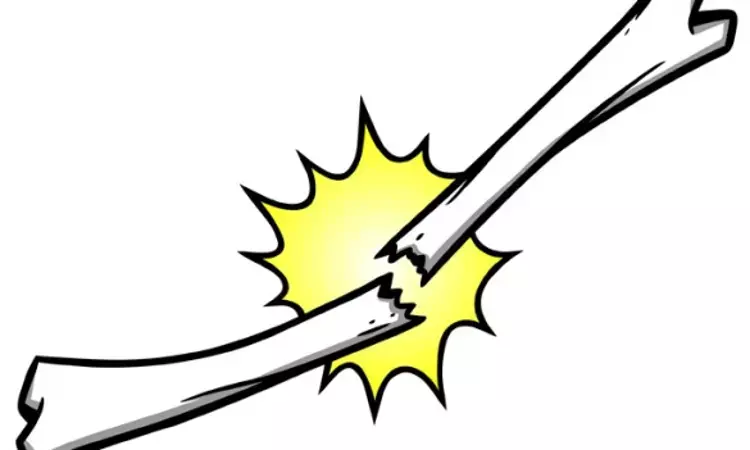- Home
- Medical news & Guidelines
- Anesthesiology
- Cardiology and CTVS
- Critical Care
- Dentistry
- Dermatology
- Diabetes and Endocrinology
- ENT
- Gastroenterology
- Medicine
- Nephrology
- Neurology
- Obstretics-Gynaecology
- Oncology
- Ophthalmology
- Orthopaedics
- Pediatrics-Neonatology
- Psychiatry
- Pulmonology
- Radiology
- Surgery
- Urology
- Laboratory Medicine
- Diet
- Nursing
- Paramedical
- Physiotherapy
- Health news
- Fact Check
- Bone Health Fact Check
- Brain Health Fact Check
- Cancer Related Fact Check
- Child Care Fact Check
- Dental and oral health fact check
- Diabetes and metabolic health fact check
- Diet and Nutrition Fact Check
- Eye and ENT Care Fact Check
- Fitness fact check
- Gut health fact check
- Heart health fact check
- Kidney health fact check
- Medical education fact check
- Men's health fact check
- Respiratory fact check
- Skin and hair care fact check
- Vaccine and Immunization fact check
- Women's health fact check
- AYUSH
- State News
- Andaman and Nicobar Islands
- Andhra Pradesh
- Arunachal Pradesh
- Assam
- Bihar
- Chandigarh
- Chattisgarh
- Dadra and Nagar Haveli
- Daman and Diu
- Delhi
- Goa
- Gujarat
- Haryana
- Himachal Pradesh
- Jammu & Kashmir
- Jharkhand
- Karnataka
- Kerala
- Ladakh
- Lakshadweep
- Madhya Pradesh
- Maharashtra
- Manipur
- Meghalaya
- Mizoram
- Nagaland
- Odisha
- Puducherry
- Punjab
- Rajasthan
- Sikkim
- Tamil Nadu
- Telangana
- Tripura
- Uttar Pradesh
- Uttrakhand
- West Bengal
- Medical Education
- Industry
Extensile lateral approach bests sinus tarsi approach in quality of fracture reduction

The extensile lateral approach (ELA) has a better overall reduction of Bohler angle on plain radiographs and of the posterior facet and tuberosity on postoperative CT scans, suggested a recent report published in the Journal of Orthopedic Trauma.
Busel, Gennadiy and colleagues from the Department of Orthopaedic Surgery, Health Partners, Department of Orthopaedic Surgery, Abbott Northwestern Hospital, Minneapolis, recently conducted a research with the objective to evaluate the difference in the quality of fracture reduction between the sinus tarsi approach (STA) and extensile lateral approach (ELA) using postoperative Computed Tomography (CT) scans in displaced intra-articular calcaneal fractures (DIACFs).
Consecutive patients undergoing operative fixation of DIACFs with postoperative CT scans and standard radiographs were included for the retrospective study design.
All operative calcaneal fractures treated by fellowship-trained orthopaedic trauma surgeons were evaluated. Seventy-seven patients with 83 fractures were included. Those with both postoperative CT scans and radiographs were included. Exclusion criteria included extra-articular fractures, malunions, percutaneous fixation, ORIF and primary fusion, and those patients without a postoperative CT scan.
The Sanders classification was used. Cases were divided into 2 groups based on ELA versus STA. Bohler angle and Gissane angle were evaluated on plain radiographs. CT reduction quality grading included articular step off/gap within the posterior facet, and varus angulation of the tuberosity: CT reduction grading included: excellent (E): no gap, no step, and no angulation; good (G): <1 mm step, <5 mm gap, and/or <5° of angulation, fair (F): 1–3 mm step, 5–10 mm gap, and/or 5–15° angulation; and poor (P): >3 mm step, >10 mm gap, and/or >15° angulation.
The following findings were recorded-
a. Average age was 42 years (range, 18–74 years), with 57 men. Four fractures were open.
b. There were 37 Sanders II and 46 Sanders III fractures; 36 fractures were fixed using the STA, whereas 47 used the ELA.
c. Average days to surgery were 5 for STA and 14 for ELA (P < 0.001).
d. A normal Bohler angle was achieved more often with the ELA (91.5%) than with STA (77.8%) (P < 0.001).
e. There was no difference by approach for Gissane angle (P = 0.5). ELA had better overall reduction quality (P = 0.02).
f. For Sanders II, there was no difference in reduction quality with STA versus ELA (P = 0.51).
g. For Sanders III, ELA trended toward better reduction quality (P = 0.06).
Therefore, the authors concluded that "for Sanders type II DIACFs, there was no difference between STA and ELA. Importantly, for Sanders III DIACFs, ELA trended toward better reduction quality."
In addition to fracture reduction, surgeon learning curve, early wound complications, and long-term outcomes must be considered in future studies comparing the ELA and STA.
Dr. Nandita Mohan is a practicing pediatric dentist with more than 5 years of clinical work experience. Along with this, she is equally interested in keeping herself up to date about the latest developments in the field of medicine and dentistry which is the driving force for her to be in association with Medical Dialogues. She also has her name attached with many publications; both national and international. She has pursued her BDS from Rajiv Gandhi University of Health Sciences, Bangalore and later went to enter her dream specialty (MDS) in the Department of Pedodontics and Preventive Dentistry from Pt. B.D. Sharma University of Health Sciences. Through all the years of experience, her core interest in learning something new has never stopped. She can be contacted at editorial@medicaldialogues.in. Contact no. 011-43720751
Dr Kamal Kant Kohli-MBBS, DTCD- a chest specialist with more than 30 years of practice and a flair for writing clinical articles, Dr Kamal Kant Kohli joined Medical Dialogues as a Chief Editor of Medical News. Besides writing articles, as an editor, he proofreads and verifies all the medical content published on Medical Dialogues including those coming from journals, studies,medical conferences,guidelines etc. Email: drkohli@medicaldialogues.in. Contact no. 011-43720751


